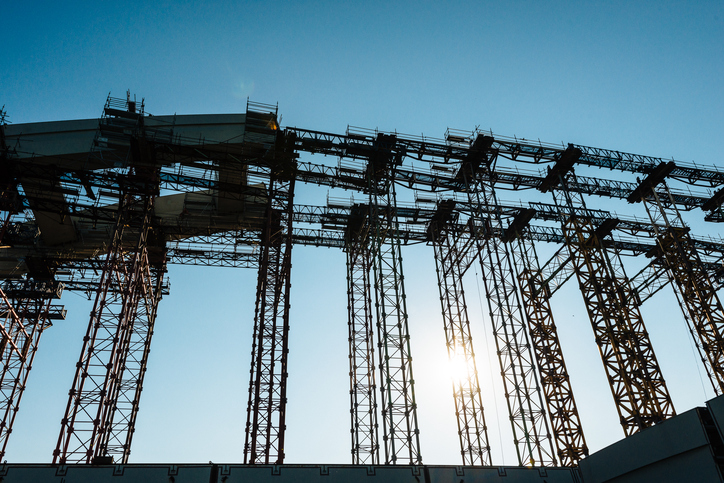

The purpose of this project was to convert the existing at-grade crossing of Brazoria County Road 56 (CR 56) and State Highway 288 (SH 288) into a diamond interchange that includes a new overpass bridge and providing access to the newly developed Meridiana Development. Coordination with TXDOT, area landowners, utility companies, and Brazoria County was integral in obtaining approval and acceptance of the project. The main design challenge for this project was to accommodate double intersections on the west side of SH 288 to tie into existing access roads with two-way traffic and a new southbound on-ramp within a close proximity. EHRA coordinated with TxDOT throughout the project from preliminary concepts for the intersection and bridge through final design and construction. Each component of this project was designed in accordance with TxDOT standards and criteria.
The facility features an activated sludge process system. Additionally, the facility is equipped with an emergency standby diesel generator.
EHRA completed a site-specific planning and visioning study for the proposed 470-acre San Jacinto Boulevard District (SJBD) in Baytown, Texas.
Project totaled 640 acres including 1256 Residential Lots. EHRA designed, created construction plans, publicly bid and preformed Construction management.
The new roadway design comprises of one-half major thoroughfare, conventional drainage, a 600-ft long bridge over Willow Fork Bayou, Retaining walls and intersection improvements at FM 1463 (including traffic signals and illumination).
When Hurricane Harvey hit Houston in the summer of 2017, damage to the city's infrastructure was considered an immediate potential threat to public health and safety during the storm. Repairing damaged structures afterwards was vital to the city's return to functioning -- though the price was steep. Moody's Analytics estimated that repair to Houston's infrastructure would cost $5 billion to $10 billion.
Using probabilistic modeling and analysis, as well as advanced computer simulation, Dan Frangopol, the inaugural Fazlur R. Khan Endowed Chair of Structural Engineering and Architecture at Lehigh University, and his research team develop the tools and techniques necessary to assess the effects of multi-hazards, such as natural disasters, on infrastructure. They find optimum solutions that can save money, time and even lives.
In their latest research, Frangopol and Mondoro integrated -- for the first time -- the three most common failure modes for bridges exposed to flooding, hurricanes, tsunamis, and other extreme hydrologic (water-related) events into a comprehensive risk assessment framework.
The work fills a key gap in the way risk for such bridges is assessed over their life-cycle. Their research was published in in Engineering Structures (Vol. 159, 2018) in an article titled "Risk-based cost-benefit analysis for the retrofit of bridges exposed to extreme hydrologic events considering multiple failure modes."
Deck, pier and foundation failure are the three most common bridge failure modes. However, the risk assessment of bridges exposed to hazards have typically included only one or two of these.
"Considering only one or two failure modes provides an incomplete picture because the risk level of each mode differs and, when assessed together, they compete with each other," says Frangopol. "Our analysis finds that any risk assessment must incorporate all pertinent failure modes of a structure."
Frangopol and Mondoro illustrate their analytical method using a riverine bridge as an example. They calculated the impact of bridge retrofit actions on possible failure modes in terms of probability of failure, risk, and benefit-cost ratio using a logic modeling technique called an event tree.
In the riverine bridge case study, all of the bridge retrofit options resulted in a reduction in the probability of failure for the examined bridge. However, these options did not provide a unilateral decrease in risk.
For example, the addition of retrofit measures to prevent deck dislodgement decreased the probability of failure of the deck, and, in turn, the bridge. However, it increased the probability of failure of the foundation. Since the consequence of a foundation failure is larger, the overall risk is increased.
"Effective management strategies will vary depending on the bridge and the intensity and frequency of the hazard to which it is exposed," says Frangopol. "This may be of particular interest in regions where the impacts of natural and anthropogenic climate changes are felt most acutely."
While the illustrative example focuses on the flooding hazard, the methodology can be applied to other extreme hydrologic events, such as hurricanes and tsunamis.
Taking the long view
Given aging U.S. infrastructure, limited public resources and the challenges created by a changing climate, the need to understand the most cost-efficient approach to the design, construction and maintenance of structures is more important than ever.
Nearly twenty years ago, Frangopol pioneered life-cycle engineering, an approach to analyzing the true cost of structures which looks at cost and performance across their entire life span. He has been developing the field ever since.
Frangopol boils the concept down to the question: "How do we encourage policy makers and engineers to take the long view rather than focus on the upfront sticker price?"
The benefits of such an approach? Cost is certainly one. According to Civil Engineering Magazine, a life-cycle cost analysis is helping the Port Authority of New York and New Jersey save an estimated $100 million over 20 years on repairs to George Washington Bridge.
Frangopol's research on bridge retrofitting is part an initiative spearheaded by the American Society of Civil Engineers (ASCE). Frangopol, as part of the ASCE Industry Leaders Council, helps lead ASCE's efforts to achieve a "Grand Challenge" of reducing the life-cycle cost of infrastructure by 50 percent by 2025.
Source: Lehigh University for Science Daily
